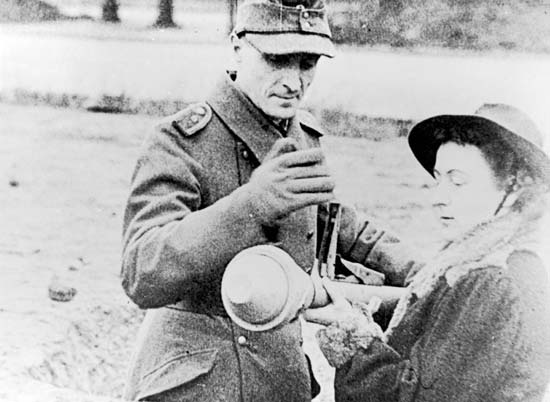Panzerfaust
weapon
 shoulder-type German antitank weapon that was widely used in World War II. The first model, the Panzerfaust 30, was developed in 1943 for use by infantry against Soviet tanks (tank). The Panzerfaust consisted of a steel tube containing a propellant charge of gunpowder. The grenade, which consisted of a small bomb attached to a wooden stem and fins, was inserted into the front end of the tube. When a firing pin on the outside of the tube was cocked, it set off a percussion cap that in turn ignited the propellant charge. This in turn propelled the grenade a short or moderate distance to the target, where it exploded. The hollow-charge head of the grenade contained enough high explosive to penetrate even the thickest tank armour. The exhaust from the propellant charge exited the rear end of the tube, making the Panzerfaust a recoilless weapon.
shoulder-type German antitank weapon that was widely used in World War II. The first model, the Panzerfaust 30, was developed in 1943 for use by infantry against Soviet tanks (tank). The Panzerfaust consisted of a steel tube containing a propellant charge of gunpowder. The grenade, which consisted of a small bomb attached to a wooden stem and fins, was inserted into the front end of the tube. When a firing pin on the outside of the tube was cocked, it set off a percussion cap that in turn ignited the propellant charge. This in turn propelled the grenade a short or moderate distance to the target, where it exploded. The hollow-charge head of the grenade contained enough high explosive to penetrate even the thickest tank armour. The exhaust from the propellant charge exited the rear end of the tube, making the Panzerfaust a recoilless weapon.The Panzerfaust 30 was a one-shot disposable weapon. Its range was only 30 metres (nearly 100 feet), but a determined operator could nevertheless destroy a tank with it. The next two models of the weapon were given larger propellant charges in order to drive grenades to distances of up to 60 and 100 metres (about 200 and 330 feet), respectively. The Panzerfaust 100, which entered service in November 1944, weighed 5 kg (11 pounds), was 104 cm (41 inches) long, and launched a grenade containing 1.6 kg (3.5 pounds) of high explosive. The fourth and last model, which was ready by early 1945, could fire 10 grenades in succession before becoming useless.
Besides the Soviet Red Army in the east, the Panzerfaust was also used against American and British tanks on the Western front. The weapon was extremely easy to load, aim, and fire, so it was widely distributed to untrained conscripts and the Volkssturm (local defense militias) in the closing phases of the war.